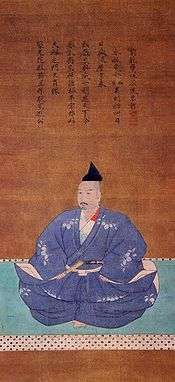Jukō-in
Entrance to Jukō-in, a sub-temple of Daitoku-ji

Miyoshi Nagayoshi, painting on silk (1566); an Important Cultural Property
Jukō-in (聚光院) is a sub-temple of Daitoku-ji, Kyoto, Japan. Founded in 1566 as the mortuary temple of Miyoshi Nagayoshi, in 1589 Sen no Rikyū designated it as the mortuary temple for his family.[1] The Hondō (1583) and chashitsu (1739) are Important Cultural Properties and the gardens have been designated a Place of Scenic Beauty.[2][3][4] A painting of Miyoshi Nagayoshi (1566) has also been designated an Important Cultural Property.[5] The temple also contains a great number of fusuma paintings done by Kanō Eitoku.
See also
- Daitoku-ji
- Japanese gardens
- Japanese painting
- List of Special Places of Scenic Beauty, Special Historic Sites and Special Natural Monuments
- List of National Treasures of Japan (paintings)
References
- ↑ Levine, Gregory P.A. (2005). Daitokuji: The Visual Cultures of a Zen Monastery. University of Washington Press. p. 107. ISBN 0-295-98540-2.
- ↑ "Database of Registered National Cultural Properties". Agency for Cultural Affairs. Retrieved 7 April 2011.
- ↑ "Database of Registered National Cultural Properties". Agency for Cultural Affairs. Retrieved 7 April 2011.
- ↑ "Database of Registered National Cultural Properties". Agency for Cultural Affairs. Retrieved 7 April 2011.
- ↑ "Database of Registered National Cultural Properties". Agency for Cultural Affairs. Retrieved 7 April 2011.
Further reading
Levine, Gregory (1997). Jukōin: Art, Architecture, and Mortuary Culture at a Japanese Zen Buddhist Temple. Princeton University (PhD diss.).
Coordinates: 35°02′38″N 135°44′43″E / 35.04389°N 135.74528°E
This article is issued from Wikipedia - version of the 11/25/2015. The text is available under the Creative Commons Attribution/Share Alike but additional terms may apply for the media files.